Cicadas are best known by the loud high-pitched sound adult male cicadas make mostly during the months of summer. Even though they are loud they are hard to locate and so well camouflaged they are difficult to spot, and typically we only see cicadas that have accidentally bumbled indoors. But sometimes we may come across exoskeletons left behind by cicada nymphs at the time of their last moult into their winged adult form.
Cicada nymphs live a subterranean life adapted to digging and feeding on the sap of roots. Most of a cicada’s life is spent in this larval state underground where they can be as deep down as 2.5 metres. For most species life underground is for two to five years, but there are some North American species that can live underground for as long as 17 years.
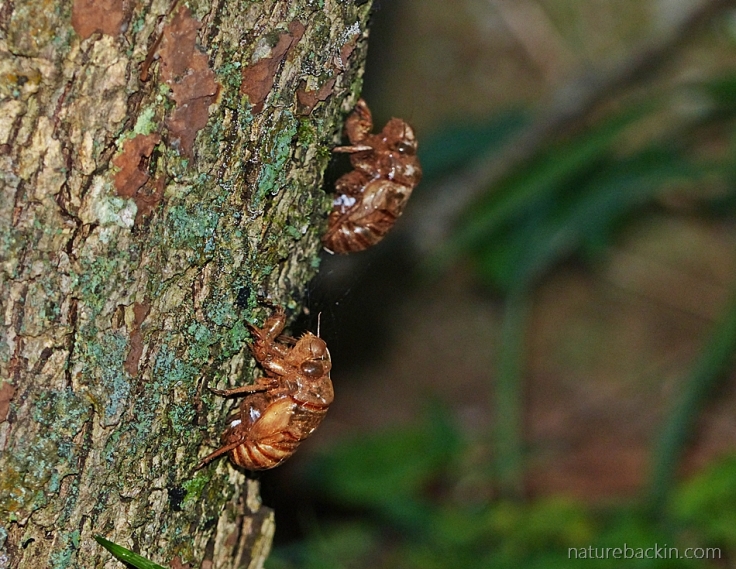
Exoskeletons of cicada nymphs can remain clinging to the bark of trees for a long time after the adults emerge from this final moult
Cicada nymphs have strong front legs adapted for digging and a single mouthpart for sucking plant fluids. Adults too have a single beak-like mouthpart for sucking fluids from plants. Cicada nymphs go through about five moults or instars during their lives underground. For the final moult when they become adults they emerge from the ground and climb up the trunk of a tree beneath which they have been living and there they shed the exoskeleton in their final moult. In some species the nymphs emerge in groups known as broods.
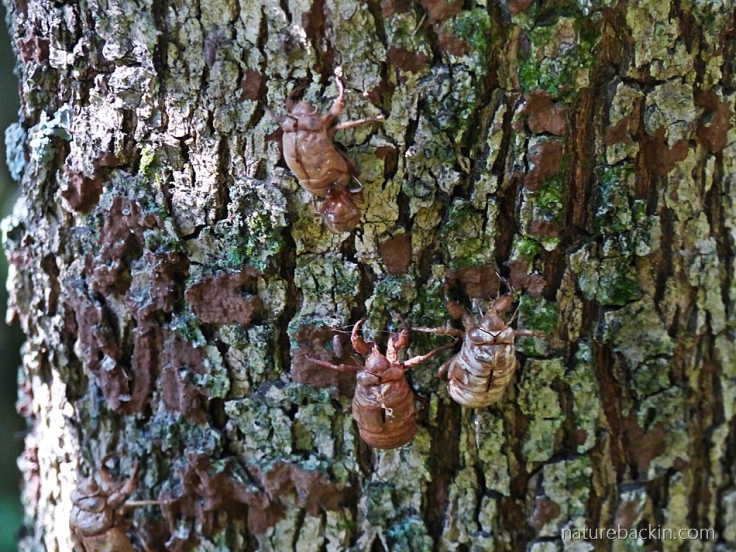
In late April this year I found many shed cicada nymph exoskeletons on the same tree and on some adjacent trees. It appears that the nymphs emerged as a group. As they are small and well camouflaged they are tricky to photograph
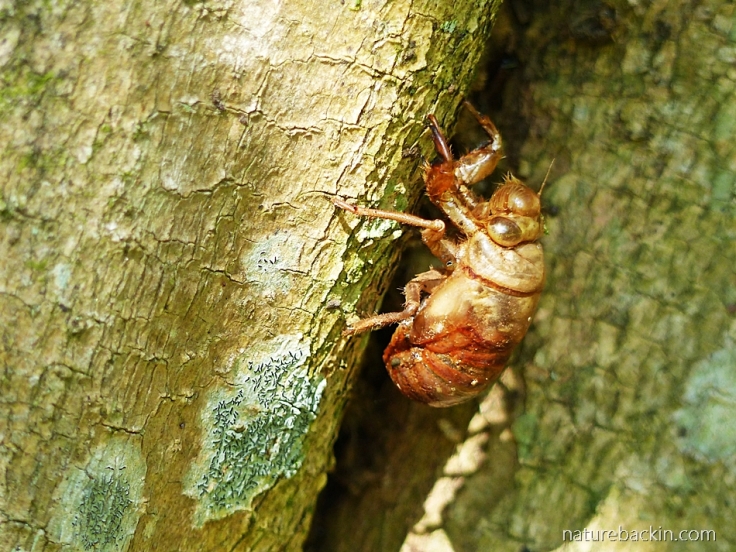
The empty exoskeleton is easier to see on a tree with paler and less fissured bark. I found at least 20 exoskeletons that remained on the tree trunks or that had fallen to the ground
There are over 3000 species of cicada in the world distributed over all continents except Antarctica, with about 150 species occurring in South Africa. Most species are fairly restricted in their range. Although in South Africa they are often referred to as Christmas Beetles (because their singing is associated with the summer Christmas holidays), Cicadas are bugs and not beetles.
Bugs have needle-like or beak-like mouthparts for piercing and sucking, whereas beetles have chewing mouthparts. Their wing structures are also different. Most bugs have membranous wings with only the base of the forewing being thickened. In most beetles the forewings, termed the elytra, are thickened and hardened so as to form an apparent casing that covers the hind wings when folded. To fly the hardened forewings are lifted to reveal the thin and membranous hindwings used for flying. Think for example of a ladybird (incorrectly sometimes called a ladybug although it is in fact a beetle). There are also differences in the composition of the antennae, with bug antennae comprising 4 or 5 segments whereas the antennae of beetles have about 11 segments. Bugs have an incomplete metamorphosis cycle with the nymphs resembling the adults and they do not pupate, whereas most beetles are grub-like in their larval stage and pupate before they become adults.
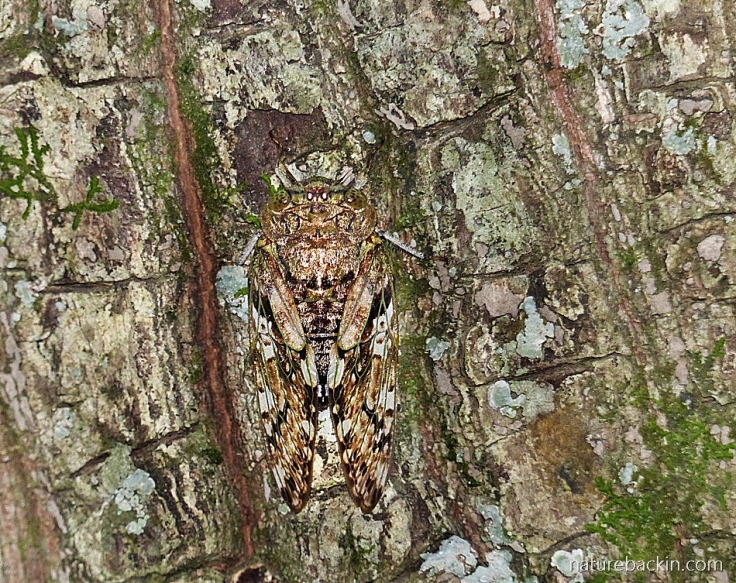
If you look carefully you can see the cicada that I photographed at Cape Vidal on the north-eastern coast of KwaZulu-Natal. As it is so well camouflaged I only saw the cicada after it emitted a low buzzing sound as I walked by. It was perched on the trunk of a tree at about head-height and so I was able to spot it
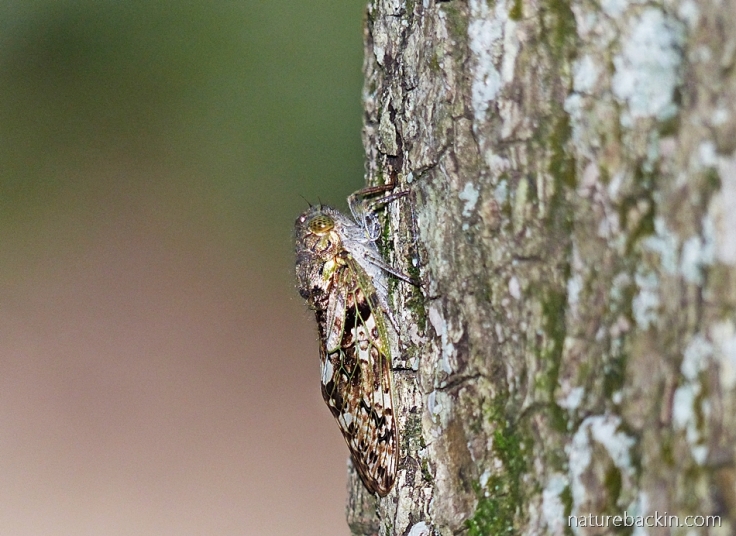
It is easier to see in profile
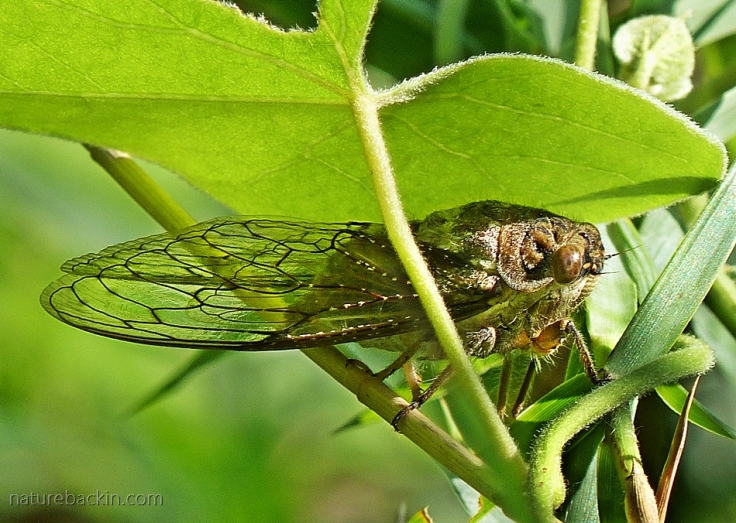
This large adult cicada was perched in vegetation on the banks of the Pongola River in Ithala Game Reserve in KwaZulu-Natal. I came across it by chance while I was watching a butterfly
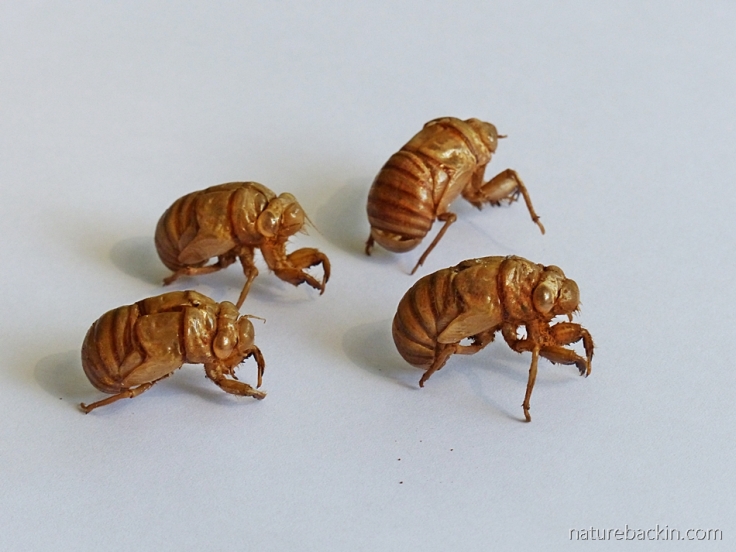
In our garden I collected some of the cicada nymph exoskeletons that I found had fallen to the ground. The strong digging forelegs are clearly visible. Grouped together and placed on white paper they resemble a small terracotta army
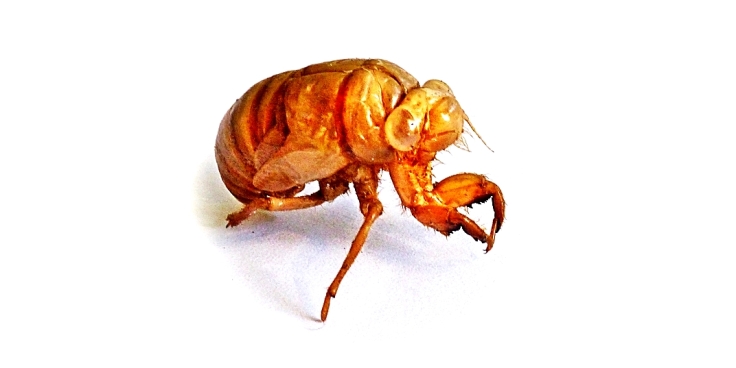
Sources:
Cicada Mania. 2019. https://www.cicadamania.com/; Lakna. 2019. What is the difference between a bug and a beetle. https://pediaa.com/what-is-the-difference-between-a-bug-and-a-beetle/; Wikipedia. 2019. Cicada. https://en.wikipedia.org/wiki/Cicada
Posted by Carol

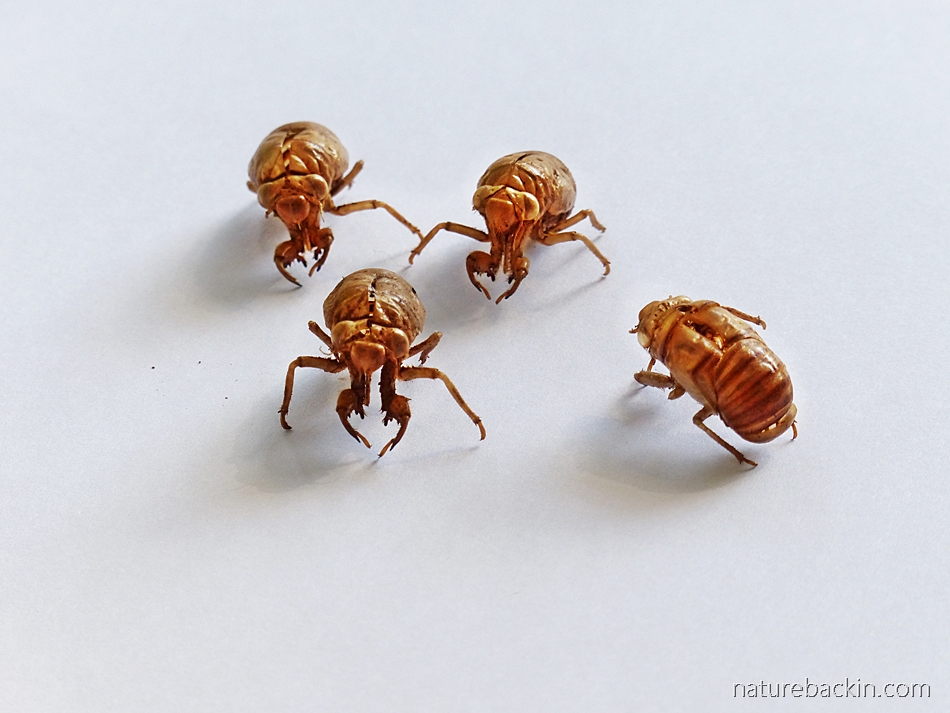







January 24, 2020 at 4:46 am
LOL🤣 at long last after 21 almost 22 years of marriage, Dave and I can call it quits on our annual disagreement on the name of this bug. I always called it the “Christmas beetle” and he always called it the “cicada” So funny, both of us are correct. 😂
Thanks for a brilliant read yet again.
LikeLiked by 1 person
January 24, 2020 at 6:52 pm
Thanks Debs. Well that is the best kind of disagreement, for it to be resolved by discovering both are right!
I remember an argument when I was a child revolving around Father Christmas vs Santa Claus. I don’t remember it being resolved, and it would have been good to learn at a young age that both can be right 🙂
Btw, the cicadas/Christmas beetles have been quite vocal this summer. Not too close to the house and lovely to hear.
LikeLike
September 3, 2019 at 11:32 am
I’m so glad to come across your post. I, too, am a fan of the Cicada. Your post was so informative and interesting. https://noelliesplace.com/2019/09/02/cicadas/
LikeLiked by 1 person
September 3, 2019 at 2:16 pm
Thanks so much Noellie. I enjoyed your post and especially the photo of the newly emerged cicada. Thank you for sharing.
LikeLiked by 1 person
July 7, 2019 at 9:50 am
They remind me a little bit of Fleas. Their sound is hot summer, their life cycle is very interesting and their camouflage is excellent! Your picture shows that in a convincing way!
LikeLiked by 1 person
July 9, 2019 at 10:45 am
I suppose their hunched posture is flea-like though they are considerably larger!
I so agree that the sound of cicadas is “hot summer” – that expresses it perfectly.
LikeLiked by 1 person
July 7, 2019 at 4:52 am
Fascinating stuff. Love the photo of the one blended against the tree bark, and the exoskeletons on the paper. It amazes me how prefect exoskeletons can be. It seems impossible that anything could actually shed something that detailed. I’m very lax about my bugs and beetles distinctions, in part because usage in the U.S.A., where I live, and England, where I was born, are often quite different.
LikeLiked by 1 person
July 9, 2019 at 10:43 am
I nearly didn’t include the photo of the well-camouflaged cicada because I thought it might be too hard to see!
I agree the minute detail that remains intact in exoskeletons is incredible, as well as that the adult is able to emerge with even very delicate bits intact.
Bug and beetle don’t sound like entomologically technical terms, and they are so often used loosely, so I was surprised when I learnt that strictly speaking they are technically distinct.
LikeLiked by 1 person
July 11, 2019 at 5:24 am
I’ve posted a few camouflage photos of various things and, even if they don’t show something clearly I think they’re great for people to really look at and discover how well some creatures blend in.
LikeLiked by 1 person
July 6, 2019 at 6:03 pm
Gosh those skeletons do look sinister. The life cycle reminds me of dragonflies, perhaps because I saw a stunning dragonfly this week and actually got a shot of it. You now have me wondering about the life cycle of crickets and grasshoppers. Do they begin life in the same way? (Rhetoricla question, I shall investigate!)
LikeLiked by 1 person
July 9, 2019 at 10:37 am
The life cycles of insects are fascinating. I gather that like cicadas, dragonflies, crickets and grasshoppers also have a three-stage life cycle.
Glad you got a photo of the dragonfly. Some of them can be cooperative perchers 🙂
LikeLiked by 1 person
July 6, 2019 at 1:48 pm
Invertebrates truly do seem alien. I remember the first time I heard one in Mexico – a buzz that squealed louder, louder, louder, until it seemed like a motorbike must be just around the corner and about to whizz past me! Definitely one of the classic sounds of the tropics.
The exoskeletons do look like terracotta!
LikeLiked by 1 person
July 9, 2019 at 10:30 am
It is incredible that such small creatures can make such a loud sound. Fortunately, mostly they don’t call at night! Sometimes the relentless daytime sound of cicadas can seem like an expression in another dimension of the hot humid summer heat we get here.
On this winter day, even though mild, this talk of cicadas raises a feeling of summer nostalgia 🙂
LikeLiked by 1 person
July 9, 2019 at 8:01 pm
And it’s the peak of our summer here of course – no cicadas, but plenty of butterflies. Still rather cold for the time of year, even by our standards. Looking forward to autumn.
LikeLike
July 5, 2019 at 7:36 am
Wonderful series of great photos. Thanks so much.
LikeLiked by 1 person
July 9, 2019 at 10:25 am
And thank you very much, Isabel.
LikeLike
July 5, 2019 at 7:01 am
A fascinating read!
LikeLiked by 1 person
July 9, 2019 at 10:24 am
Thank you Anne.
LikeLike
July 5, 2019 at 2:00 am
Wow the camouflage is utterly amazing and even more amazing that you managed to see or find it. The exoskeletons are a bit ‘creepy’ but I suppose that’s just because I tend to prefer soft and furry. 😉
I suppose it’s just the USA. We don’t know a bug from a beetle. I’ve always known them as ladybugs.
LikeLiked by 1 person
July 5, 2019 at 5:06 am
Maybe their hunched posture, strong forelegs and large empty eyes add to their ‘creepiness’.
Ladybeetles and Christmas Bugs require quite an adjustment even if more correct! When you think about it, the name Ladybird is actually quite odd 😊
LikeLike
July 5, 2019 at 1:58 am
Another fascinating post, Carol! They are so well camouflaged, and yet you’ve managed to show them off perfectly in their natural surroundings. Even more amazing how long-lived they are, I for one think of insects as having fast and hard lives!
And the resemblance of your posed exoskeletons to China’s terracotta army is astounding!
LikeLiked by 1 person
July 5, 2019 at 4:59 am
I was also astonished at their long lives. I am glad you can also see their odd resemblance to the terracotta army😊
LikeLiked by 1 person
July 4, 2019 at 10:57 pm
They’re amazing creatures. On the east coast of Australia their sound is so loud you feel as though it could pierce your eardrums, and they have great names such as Greengrocer, Yellow Monday, Floury Baker and Black Prince.
LikeLiked by 1 person
July 5, 2019 at 4:56 am
Some species can be literally ear splitting! Thanks for those names, they are great and most intriguing.
LikeLike
July 4, 2019 at 8:41 pm
That’s an utterly extraordinary life cycle. And yes, it would work well as part of a sci-fi drama. 17 years below ground, eh?
LikeLiked by 1 person
July 4, 2019 at 9:08 pm
Wow these are amazing Carol. Great find and photos! 🙂
LikeLiked by 2 people
July 5, 2019 at 4:52 am
Thanks Pete. I am glad I found them. A couple of months later several are still clinging to their tree trunks!
LikeLiked by 1 person
July 5, 2019 at 4:49 am
They are extraordinary. This is the first time I have heard of insects that live so long.
LikeLiked by 1 person
July 4, 2019 at 8:34 pm
They look like something you’d see in a sci-fi film!
LikeLiked by 2 people
July 5, 2019 at 4:46 am
Yes they do! It seems sci-fi designers draw heavily on the insect world for inspiration.
LikeLiked by 1 person